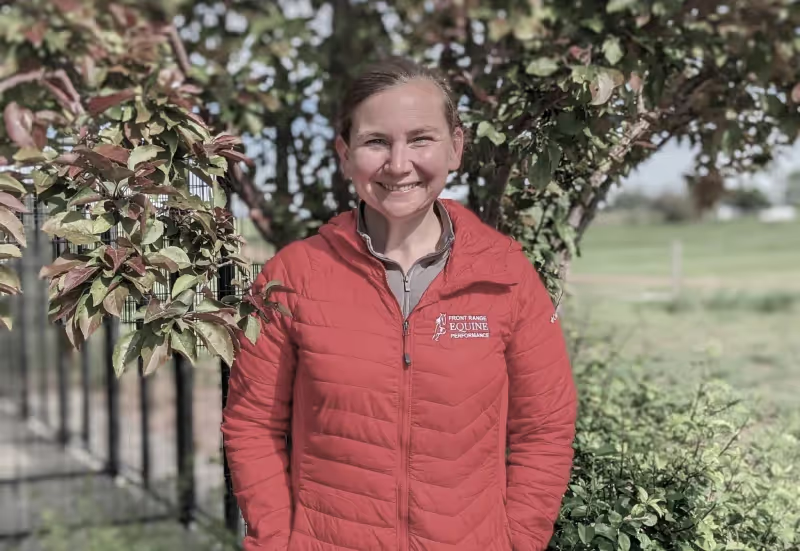
7 July 2023
“With appropriate rehabilitation you can prevent many injuries – and even make horses with severe injuries come back to full functionality. Objective motion analysis is a great tool in highlighting potentially serious problems for the owner and to convince them that rehabilitation is worth it”, she says.
When asked about her all-time favourite horse, Marianne Marshall-Gibson refers to the 5-year-old thoroughbred, “Doc”, that she saved from being euthanised a year ago, now recuperating under her care. This is symptomatic for a person who has dedicated much of her life and career to furthering her skills in equine rehabilitation.
Marianne Marshall-Gibson grew up outside Chicago at a hunter/jumper and dressage facility with 54 show horses, run by her parents. Although she learnt to ride at an early age, it was caring for the horses that turned into her great passion.
"I preferred staying at home during weekends looking after the injured horses, rather than going to shows. Hanging out with the vets when they were making diagnoses and working to rehabilitate the horses was the coolest thing, I thought. I guess my desire to become a vet and my passion for rehabilitation were fostered there."
After academic studies resulting in an M.S in Biomedical Sciences-Cancer Biology, she earned a doctorate in Veterinary Medicine at Colorado State University, while also being certified in Veterinary Medical Acupuncture as well as Equine Rehabilitation and Performance Medicine. Today, Marianne Marshall-Gibson runs the Front Range Equine Performance Center in Colorado along with a team of veterinarians and veterinary technicians, specialising in equine sports medicine and rehabilitation. The clinic currently has about 2,500 active clients.
Her keen interest in sports medicine, lameness, acupuncture, chiropractic and laser therapy, means Marianne Marshall-Gibson sees many sport horses.
"One of my greatest challenges is to convince people that their horse has a problem – and that they need to perhaps refrain from the show next weekend to make sure that it isn’t a serious injury waiting to happen. That’s where Sleip comes in for me, it’s a great help to be able to clearly show the asymmetries. The other area I find motion analysis really helpful is convincing people that serious rehabilitation is worth it."
Marianne Marshall-Gibson says that seeing horses with serious injuries come back after a correct rehabilitation program is a great and constant inspiration.
"The first horse we had in our rehabilitation centre had fractured its hock and didn’t have a great prognosis, but the owner wanted to try. We had him at our centre for six months and then at a controlled space at the owner’s facility, where we were constantly checking on him. That horse, which most people thought should be euthanized and would never return to riding, eventually came back to jumping. To bring the horse back to good life, and to make the owner happy, is the biggest reward for me", she says.
Paramount to succeed in rehabilitation is to make a correct diagnosis to see exactly what is wrong so that you can tailor a program for each specific horse. You need to look at the whole horse to determine the best measures, according to Marianne Marshall-Gibson.
“Because lameness and loss of performance can be caused by a multitude of problems, it is important to take a comprehensive, holistic approach to every case. The strategy at our clinic is to begin by studying all available patient history. We then approach each problem with a “from scratch” attitude, evaluating every relevant aspect of the horse’s performance issue. Our goal is to identify the root cause of the problem and to prescribe an effective treatment and rehabilitation plan.”
“Many problems come back to core strength. Many people don’t realise the importance of focussing on the horse’s core, which is the place and foundation of movement in general.”
“Even-mirrored gaits, focusing on getting the horse to do the movements correctly and engaging its core is a good place to start – also to make sure that they stay straight and balanced. This is important for any training program – as well as successful rehabilitation, says Marianne Marshall-Gibson.
In many rehabilitation programs you come to stages where you don’t see any progress.
“Sleip can be very useful to measure if we’re going in the right direction - or if we need to back off for a week or so. It can also help us show this to the owner. At our rehabilitation centre, we use it weekly. We also use it for an objective soundness evaluation of our clients’ show or performance horses when they are in for their regular check-ups, to compare data from the last check-up.”
“I’m also curious if we could perhaps use it for pre-purchase evaluations – and I think a lot of owners could be interested in this prior to selling a horse to know if there is anything that might be detected during an exam."
Dr. Marshall-Gibson is licensed in Colorado, Wyoming, California and Washington State. She serves as the on-site veterinarian for the Steamboat Springs PRCA Pro-Rodeo Series along with High Country Veterinary Services. She is a member of the American Association of Equine Practitioners (AAEP), the American Veterinary Medical Association (AVMA) and the Colorado Veterinary Medical Association (CVMA), and the American Veterinary Chiropractic Association (AVCA).
When not serving her Front Range Equine clients, Dr. Marshall-Gibson assists fellow veterinarians to grow their practice by providing rehabilitation and lameness consulting and Equine Performance Partnerships. She is also passionate about furthering the future of equine veterinary medicine through teaching and mentoring veterinary students and other veterinarians in diagnostic imaging and sports medicine diagnostics and techniques.